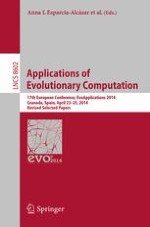This book constitutes the thoroughly refereed post-conference proceedings of the International Conference on the Applications of Evolutionary Computation, EvoApplications 2014, held in Granada, Spain, in April 2014, colocated with the Evo* 2014 events EuroGP, EvoCOP, and EvoMUSART.
The 79 revised full papers presented were carefully reviewed and selected from 128 submissions. EvoApplications 2014 consisted of the following 13 tracks: EvoCOMNET (nature-inspired techniques for telecommunication networks and other parallel and distributed systems), EvoCOMPLEX (evolutionary algorithms and complex systems), EvoENERGY (evolutionary computation in energy applications), EvoFIN (evolutionary and natural computation in finance and economics), EvoGAMES (bio-inspired algorithms in games), EvoIASP (evolutionary computation in image analysis, signal processing, and pattern recognition), EvoINDUSTRY (nature-inspired techniques in industrial settings), EvoNUM (bio-inspired algorithms for continuous parameter optimization), EvoPAR (parallel implementation of evolutionary algorithms), EvoRISK (computational intelligence for risk management, security and defence applications), EvoROBOT (evolutionary computation in robotics), EvoSTOC (evolutionary algorithms in stochastic and dynamic environments), and EvoBio (EC and related techniques in bioinformatics and computational biology).
